延续性与非延续性动词在现在完成时态中的使用
- 格式:doc
- 大小:28.00 KB
- 文档页数:1
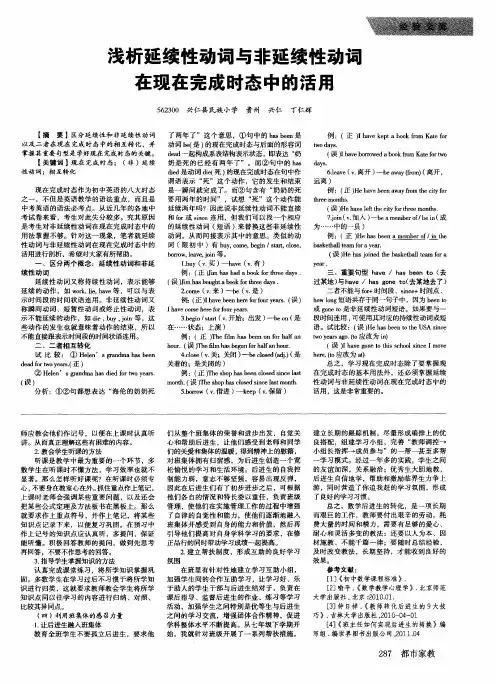

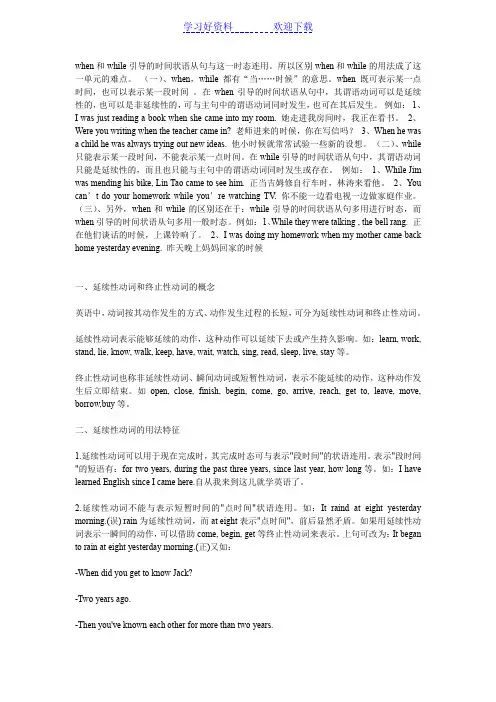
when和while引导的时间状语从句与这一时态连用。
所以区别when和while的用法成了这一单元的难点。
(一)、when,while都有“当……时候”的意思。
when既可表示某一点时间,也可以表示某一段时间。
在when引导的时间状语从句中,其谓语动词可以是延续性的,也可以是非延续性的,可与主句中的谓语动词同时发生,也可在其后发生。
例如:1、I was just reading a book when she came into my room. 她走进我房间时,我正在看书。
2、Were you writing when the teacher came in? 老师进来的时候,你在写信吗?3、When he was a child he was always trying out new ideas. 他小时候就常常试验一些新的设想。
(二)、while 只能表示某一段时间,不能表示某一点时间。
在while引导的时间状语从句中,其谓语动词只能是延续性的,而且也只能与主句中的谓语动词同时发生或存在。
例如:1、While Jim was mending his bike, Lin Tao came to see him. 正当吉姆修自行车时,林涛来看他。
2、You can’t do your homework while you’re watching TV. 你不能一边看电视一边做家庭作业。
(三)、另外,when和while的区别还在于:while引导的时间状语从句多用进行时态,而when引导的时间状语从句多用一般时态。
例如:1、While they were talking , the bell rang. 正在他们谈话的时候,上课铃响了。
2、I was doing my homework when my mother came back home yesterday evening. 昨天晚上妈妈回家的时候一、延续性动词和终止性动词的概念英语中,动词按其动作发生的方式、动作发生过程的长短,可分为延续性动词和终止性动词。
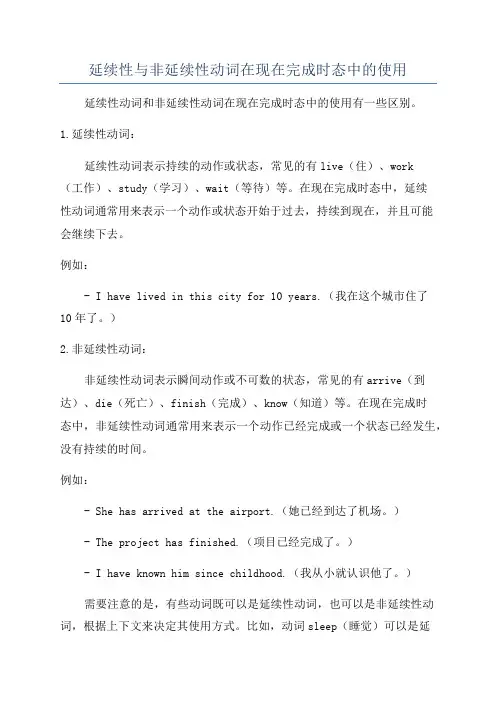
延续性与非延续性动词在现在完成时态中的使用
延续性动词和非延续性动词在现在完成时态中的使用有一些区别。
1.延续性动词:
延续性动词表示持续的动作或状态,常见的有live(住)、work
(工作)、study(学习)、wait(等待)等。
在现在完成时态中,延续
性动词通常用来表示一个动作或状态开始于过去,持续到现在,并且可能
会继续下去。
例如:
- I have lived in this city for 10 years.(我在这个城市住了
10年了。
)
2.非延续性动词:
非延续性动词表示瞬间动作或不可数的状态,常见的有arrive(到达)、die(死亡)、finish(完成)、know(知道)等。
在现在完成时
态中,非延续性动词通常用来表示一个动作已经完成或一个状态已经发生,没有持续的时间。
例如:
- She has arrived at the airport.(她已经到达了机场。
)
- The project has finished.(项目已经完成了。
)
- I have known him since childhood.(我从小就认识他了。
)
需要注意的是,有些动词既可以是延续性动词,也可以是非延续性动词,根据上下文来决定其使用方式。
比如,动词sleep(睡觉)可以是延
续性动词,表示持续的睡眠状态,也可以是非延续性动词,表示一次性的睡眠动作。
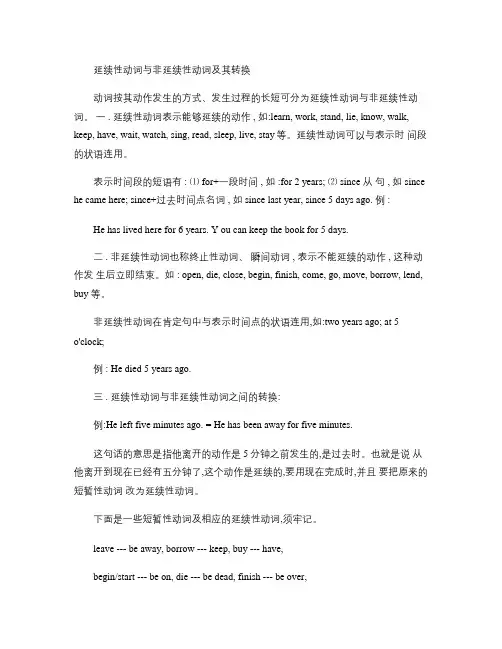
延续性动词与非延续性动词及其转换动词按其动作发生的方式、发生过程的长短可分为延续性动词与非延续性动词。
一 . 延续性动词表示能够延续的动作 , 如:learn, work, stand, lie, know, walk, keep, have, wait, watch, sing, read, sleep, live, stay等。
延续性动词可以与表示时间段的状语连用。
表示时间段的短语有 : ⑴ for+一段时间 , 如 :for 2 years; ⑵ since 从句 , 如 since he came here; since+过去时间点名词 , 如 since last year, since 5 days ago. 例 :He has lived here for 6 years. Y ou can keep the book for 5 days.二 . 非延续性动词也称终止性动词、瞬间动词 , 表示不能延续的动作 , 这种动作发生后立即结束。
如 : open, die, close, begin, finish, come, go, move, borrow, lend, buy 等。
非延续性动词在肯定句中与表示时间点的状语连用,如:two years ago; at 5o'clock;例 : He died 5 years ago.三 . 延续性动词与非延续性动词之间的转换:例:He left five minutes ago. = He has been away for five minutes.这句话的意思是指他离开的动作是 5分钟之前发生的,是过去时。
也就是说从他离开到现在已经有五分钟了,这个动作是延续的,要用现在完成时,并且要把原来的短暂性动词改为延续性动词。
下面是一些短暂性动词及相应的延续性动词,须牢记。
leave --- be away, borrow --- keep, buy --- have,begin/start --- be on, die --- be dead, finish --- be over,join --- be in+组织机构 , be a member of+组织机构 ,open sth --- keep sth open, fall ill --- be ill, get up---be up,catch a cold --- have a cold, come here --- be here,go there --- be there, become --- be, come back --- be back,fall asleep --- be asleep, get to/ arrive/reach --- be (in,leave --- be away from, get to know --- know,go (get out → be out, put on→ wear ; catch a cold → have a cold等。
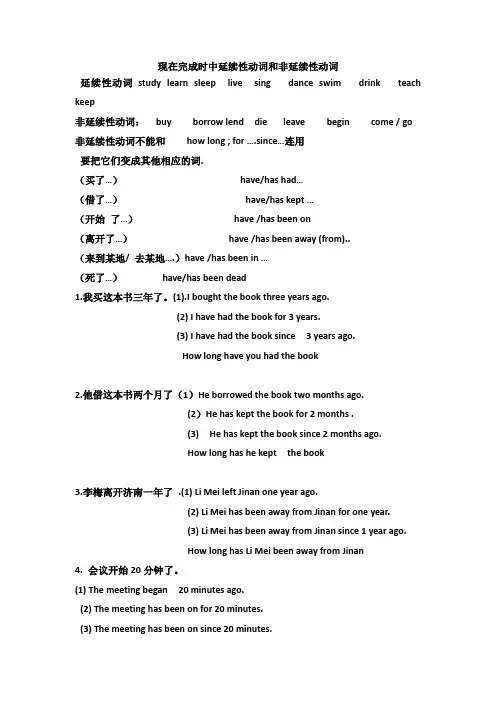
现在完成时中延续性动词和非延续性动词延续性动词study learn sleep live sing dance swim drink teach keep非延续性动词:buy borrow lend die leave begin come / go 非延续性动词不能和how long ; for ….since…连用要把它们变成其他相应的词.(买了…)have/has had…(借了…)have/has kept …(开始了…)have /has been on(离开了…)have /has been away (from)..(来到某地/ 去某地….)have /has been in …(死了…)have/has been dead1.我买这本书三年了。
(1).I bought the book three years ago.(2) I have had the book for 3 years.(3) I have had the book since 3 years ago.How long have you had the book2.他借这本书两个月了(1)He borrowed the book two months ago.(2)He has kept the book for 2 months .(3) He has kept the book since 2 months ago.How long has he kept the book3.李梅离开济南一年了.(1) Li Mei left Jinan one year ago.(2) Li Mei has been away from Jinan for one year.(3) Li Mei has been away from Jinan since 1 year ago.How long has Li Mei been away from Jinan4. 会议开始20分钟了。

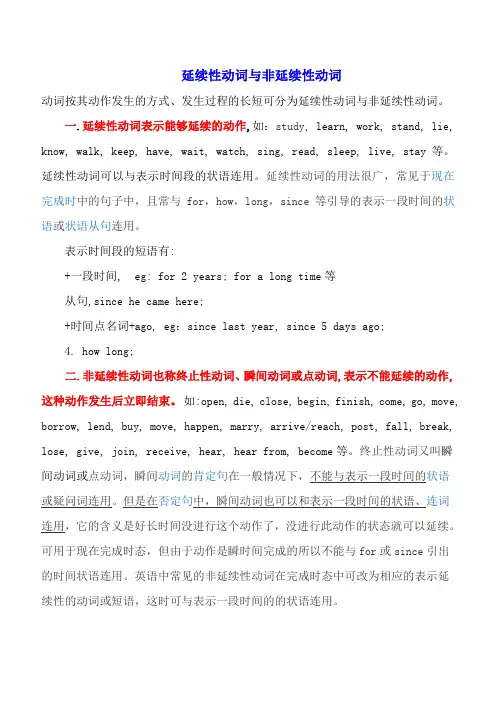
延续性动词与非延续性动词动词按其动作发生的方式、发生过程的长短可分为延续性动词与非延续性动词。
一.延续性动词表示能够延续的动作,如:study, learn, work, stand, lie, know, walk, keep, have, wait, watch, sing, read, sleep, live, stay等。
延续性动词可以与表示时间段的状语连用。
延续性动词的用法很广,常见于现在完成时中的句子中,且常与for,how,long,since等引导的表示一段时间的状语或状语从句连用。
表示时间段的短语有:+一段时间, eg: for 2 years; for a long time等从句,since he came here;+时间点名词+ago, eg:since last year, since 5 days ago;4. how long;二.非延续性动词也称终止性动词、瞬间动词或点动词,表示不能延续的动作,这种动作发生后立即结束。
如:open, die, close, begin, finish, come, go, move, borrow, lend, buy, move, happen, marry, arrive/reach, post, fall, break,有for+一段时间的完成时态中。
常见的这类动词有: go, come, leave, arrive, lose, land, catch, join, kill, find 等。
例如:1. He has joined the club for a long time. ( 错 )2. He has been a member of the club for a long time. ( 对 )3. His grandfather has died for over 30 years. ( 错 )4. His grandfather has been dead for over 30 years. ( 对 )【注意】之所以将这些动词称为瞬间动词,是因为这些动词在眨眼之间发生并终结。
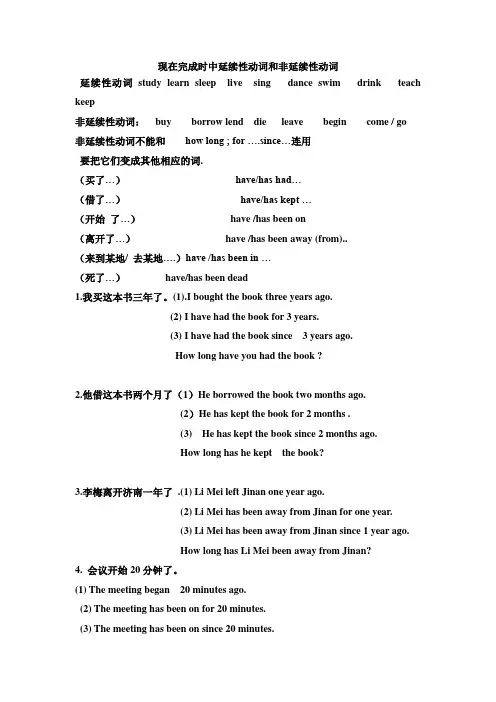
现在完成时中延续性动词和非延续性动词延续性动词study learn sleep live sing dance swim drink teach keep非延续性动词:buy borrow lend die leave begin come / go非延续性动词不能和how long ; for ….since…连用要把它们变成其他相应的词.(买了…)have/has had…(借了…)have/has kept …(开始了…)have /has been on(离开了…)have /has been away (from)..(来到某地/ 去某地….)have /has been in …(死了…)have/has been dead1.我买这本书三年了。
(1).I bought the book three years ago.(2) I have had the book for 3 years.(3) I have had the book since 3 years ago.How long have you had the book ?2.他借这本书两个月了(1)He borrowed the book two months ago.(2)He has kept the book for 2 months .(3) He has kept the book since 2 months ago.How long has he kept the book?3.李梅离开济南一年了.(1) Li Mei left Jinan one year ago.(2) Li Mei has been away from Jinan for one year.(3) Li Mei has been away from Jinan since 1 year ago.How long has Li Mei been away from Jinan?4. 会议开始20分钟了。
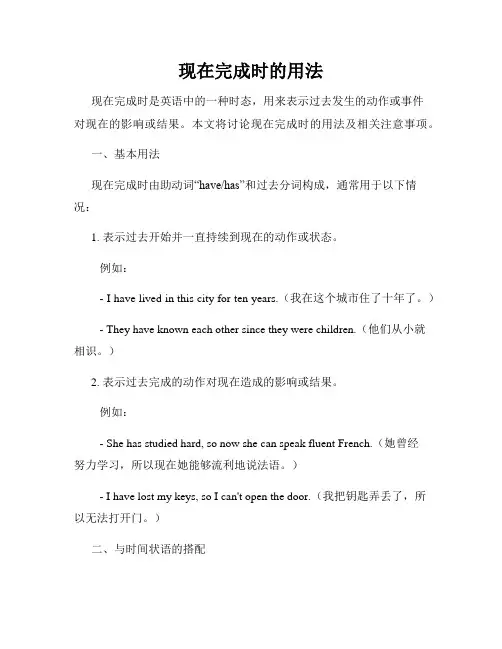
现在完成时的用法现在完成时是英语中的一种时态,用来表示过去发生的动作或事件对现在的影响或结果。
本文将讨论现在完成时的用法及相关注意事项。
一、基本用法现在完成时由助动词“have/has”和过去分词构成,通常用于以下情况:1. 表示过去开始并一直持续到现在的动作或状态。
例如:- I have lived in this city for ten years.(我在这个城市住了十年了。
) - They have known each other since they were children.(他们从小就相识。
)2. 表示过去完成的动作对现在造成的影响或结果。
例如:- She has studied hard, so now she can speak fluent French.(她曾经努力学习,所以现在她能够流利地说法语。
)- I have lost my keys, so I can't open the door.(我把钥匙弄丢了,所以无法打开门。
)二、与时间状语的搭配现在完成时经常与表示过去发生的时间状语连用,具体可以分为以下几种情况:1. 点时间状语:表示具体的某个时间点。
例如:- I have visited Beijing three times.(我已经去过北京三次了。
) - She has finished her homework just now.(她刚刚完成了作业。
)2. 时间段状语:表示某一段时间的延续。
例如:- They have been friends for many years.(他们已经是多年的朋友了。
)- We haven't seen each other since last summer.(我们自去年夏天以来就没见面了。
)3. 到目前为止的状语:表示从过去某一时间到现在为止。
例如:- He has already eaten lunch.(他已经吃过午饭了。
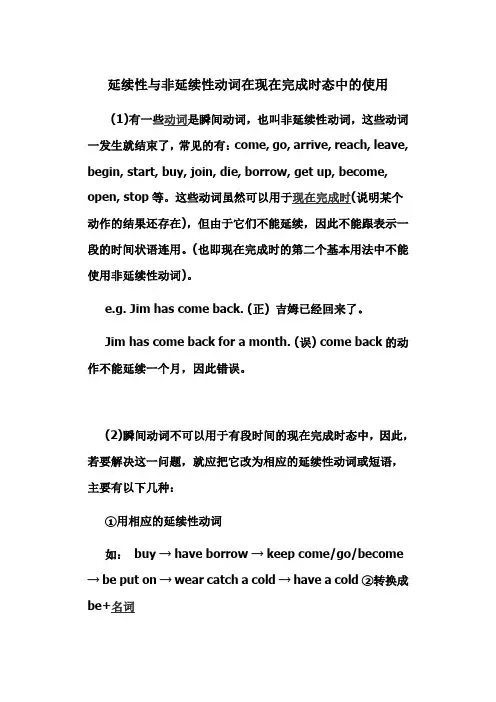
延续性与非延续性动词在现在完成时态中的使用一发生就结束了,常见的有:come, go, arrive, reach, leave, begin, start, buy, join, die, borrow, get up, become,动作的结果还存在),但由于它们不能延续,因此不能跟表示一段的时间状语连用。
(也即现在完成时的第二个基本用法中不能使用非延续性动词)。
e.g. Jim has come back. (正) 吉姆已经回来了。
Jim has come back for a month. (误) come back的动作不能延续一个月,因此错误。
(2)瞬间动词不可以用于有段时间的现在完成时态中,因此,若要解决这一问题,就应把它改为相应的延续性动词或短语,主要有以下几种:①用相应的延续性动词如:buy → have borrow → keep come/go/become → be put on → wear catch a cold → have a cold ②转换成如:join → be a member of go to school → be a如:die → be dead leave → be away begin → be on finish → be over fall asleep — be asleep open → be语如:come to/go to/arrive in (at)/get to/reach …→be in/at… join the army → be in the army(军队)e.g. I have borrowed the book. 我已经借了那本书。
I have kept the book for two days. 我已经借那本书两天了。
Jim has joined the band. 吉姆已经加入那乐队了。
Jim has been a member of the band for a month. 吉姆已经加入那个乐队一个月了。
现在完成时之延续性分词和非延续性动词现在完成时中,非延续性动词不能与for和since引导的表示一段时间的状语连用,通常是用相应的延续性动词来代替。
(就是说:有for或since 的句子里,一定不能是非延续性代词,必须是延续性动词)。
例如:borrow借→ keep保存, buy买→ have拥有, begin/start 开始→ be on上映, die死→ be dead死(表状态), join参加→ be in/be a member of-加入;成为……中的一员,come/arrive 来/到达→ be here/in, come/get back回来→ be back, go/leave 走/离开→ be away(from), marry结婚→ be married(to),go/come/begin/start/die/buy/borrow/sell/leave/arrive/receive/become等词语是瞬间动词,表示的动作是一时的,不能延续,不能与for、since等表示一段时间的词连用,也不能用于how long引导的疑问句中。
•如不能说:He has borrowed the book for two months.(ⅹ)•但可以说:He has kept the book for 2 months.•或:It has been 2 months since he borrowed the book.•或:Two months has passed since he borrowed the book.※注意:用句型转换的方法,很容易排除非延续动词在有for/since结构的完成时中的误用。
1)(对)Tom has studied Russian for three years. = Tom began to study Russian three years ago, and is still studying it now.2)(错)Harry has got married for six years. = Harry began to get married six years ago, and is still getting married now.显然,第二句不对,它应改为Harry got married six years ago. 或Harry has been married for six years.难点:比较一般过去时与现在完成时1)一般过去时——表示过去某时发生的动作或单纯叙述过去的事情,强调动作;现在完成时——发生在过去,强调过去的事情对现在的影响,强调影响。
现在完成时的延续性动词与非延续性动词动词可分为延续性动词和非延续性动词(也称短暂性或瞬间动词),取决于动作发生的方式和过程的长短。
延续性动词可以与表示时间段的状语连用,如“for”加一段时间,比如“for2 years”,或者“since”加从句或过去时间点,比如“since he came here”或“since last year”、“since 5 days ago”。
非延续性动词表示不能延续的动作,一旦发生就立即结束。
在现在完成时的肯定句中,短暂性动词不能与表示时间段的“for”短语、since短语或从句连用,也不能与表示时间段的how long引起的疑问句连用。
例如,不能说“I have bought the book for 2 weeks”,而应该说“I have bought the book”,或者“I have had the book for two weeks”。
同样地,不能说“I have bought the book since twowee ks ago”或“I have bought the book two weeks ago”。
对于非延续性动词,可以使用其他方式表达。
比如,“The old man died 4 years ago”可以改为“The old man has been deadfor 4 years”、“It is/has been 4 years since the old man died”或“Four years has passed since the old man died”。
有时候,可以将短暂性动词转换为延续性动词。
例如,“go(to)/come(to)/XXX”可以改为“XXX”,“return/go back/come back”可以改为“be back”。
举个例子,可以说“XXX minutes ago”或“He has been in Beijing for ten minutes”;“My sister XXX”可以改为“My sister has been an engineer since 2005”。
现在完成时中的谓语动词1、非延续性动词就是指动作在瞬间结束,不能持续或延续的动词,又叫瞬间动词或点动词。
比如:leave, arrive, come, go, start, begin, finish, end, join, die, buy, borrow, move, fall asleep, get to know, go out, go away, get up等.非延续性动词可以用完成时,但不可以与表示一段时间的状语连用(如for 3 days, since 1996);2、延续性动词就是指动作可以持续进行的动词,比如:be on, be away, keep, have, live ,learn,study, read, write…延续性动词可以与表示一段时间的时间状语连用(for two years, since 1996…)3、常用瞬间动词变延续性动词表常用短暂性动词变延续性动词表+相应的介词:1). have arrived at/in sp. 、got to/reached sp. 、come/gone/moved to sp. ——have been in sp./a t… 2). have come/gone back/returned ——have been back3). have come/gone out ——have been out4). have become ——have been5). have closed / opened ——have been closed/opened6). have got up ——have been up;7). have died ——have been dead;8). have left sw. ——have been away from sw.9). have fallen asleep/got to sleep —— have been asleep;10). have finished/ended/completed ——have been over;11). have married ——have been married;12). have started/begun to do sth. —— have done sth. ;13). have begun ——have been on14). have borrowed/bought ——have kept/had15). have lost ——haven’t had16). have put on ——have worn17). have caught /get a cold ——have had a cold;18). have got to know —— have known19). have/has gone to ——have been in20). have joined/have taken part in the league/the Party/the army —— have been a member of/ have been in/have been the Party’s member/the league member/the soldier…例:1.他入党五年了。
延续性与非延续性动词在现在完成时态中的使用
☆有一些动词是瞬间动词,也叫非延续性动词,这些动词一发生就结束了,常见的有:come, go, arrive, reach, leave,begin, start, buy, join, die, borrow, get up, become, open, stop等。
这些动词虽然可以用于现在完成时(说明某个动作的结果还存在),但由于它们不能延续,因此不能跟表示一段的时间状语连用。
e.g. Jim has come back. (正)
Jim has come back for a month. (误) come back的动作不能延续一个月,因此错误。
☆瞬间动词不可以用于有段时间的现在完成时态中,因此,若要解决这一问题,就应把它改为相应的延续性动词或短语,主要有以下几种:
①用相应的延续性动词
如:buy →have borrow →keep come/go/become →be
put on →wear catch a cold →have a cold
②转换成be+名词
如:join →be a member of go to school →be a student
③转换成be+形容词或副词
如: die →be dead leave →be away begin →be on finish →be over fall asleep —be asleep open →be open get up →be up close →be closed
④转换成be+介词短语
如: come to/go to/arrive in (at)/get to/reach …→be in/at… join the army →be in the army(军队)
e.g. I have borrowed the book. I have kept the book for two days.
Jim has joined the band. Jim has been a member of the band for a month.
His grandfather has died. His grandfather has been dead for 2 years.
My father has arrived in China. My father has been in China for a week.
☆在否定句中,非延续性动词也可以与时间段连用。
e.g. I haven’t borrowed books from the library since last year. 自去年以来我就没有在图书馆借过书。
Jim hasn’t come back for a year. 吉姆已有一年没回来了。
☆现在完成时的几种常见的句型转换。
现在完成时可以转化成一般过去时,还可以转化成“It is/has been +时间段+since从句(用一般过去时)”等句型。
e.g. Jim has been back for a month.
= Jim came back a month ago.
= It is/has been a month since Jim came back.
= A month has passed since Jim came back.
I have kept the book for two days.
= I borrowed the book two days ago.
= It is / has been two days since I borrowed the book.
= Two days has passed since I borrowed the book.。